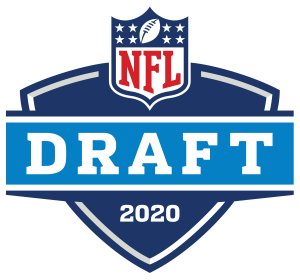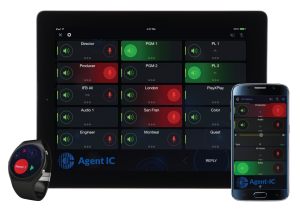NFL Draft Reflections: Intercoms Keep the Back Channels Open
Clear-Com’s IP gear helps a complex production go truly ‘at home’
Story Highlights
There were about three weeks to go before the kickoff of the NFL Draft, scheduled to take place live in Paradise, NV, the last week of April. Then came the pandemic, locking down the country one state at a time. By the time it reached Paradise, NFL Commissioner Roger Goodell had decided that the event would take place virtually, from the homes and other lockdown locations of every player, coach, owner, and technician involved — and the basement of Goodell’s own home. The decision would have far-reaching implications for the one platform that connected every person involved in getting the show online: intercoms.
All production communications were to be handled by a combination of national event-production vendor Freeman; Buffalo, NY-based comms-systems supplier Sound and Vision Entertainment (SAV); and Orlando-based consultant Show Machine — all of which have done this task for the NFL Draft for more than a decade. Suddenly, a year’s worth of planning had to be completely revised in a matter of weeks.
 “We usually start thinking about next year’s Draft production right after the current year’s is done, if not during its last few hours,” recalls Show Machine owner Dave Ragains. “This year, we had to go in a completely different direction in less than three weeks.”
“We usually start thinking about next year’s Draft production right after the current year’s is done, if not during its last few hours,” recalls Show Machine owner Dave Ragains. “This year, we had to go in a completely different direction in less than three weeks.”
For the first time ever, the annual meeting of the NFL’s football franchises to select newly eligible players for the upcoming season was held via video conference, April 23-25, as a result of worldwide travel restrictions.
Hybrid Approach
Key to making this radically altered event work was implementation of a hybrid intercom system that uses both conventional and IT-based components. Specifically, a Clear-Com Eclipse HX digital matrix system along with LQ IP Series — which integrates into existing workflows and connects securely over 3G, 4G, LTE, or Wi-Fi networks — was the chosen intercom solution to support the large network of remote Agent-IC intercom app clients required for this virtualized broadcast.
“When the decision was made to virtualize the Draft broadcast, we were tasked to come up with a reliable and secure remote-communications solution that would enable a large number of production staff to operate from their homes while still being able to communicate on the production intercom freely over many channels,” explains Brady Belavek, who runs the comms audio for SAV. “What turned out to be one of the biggest challenges was managing ISP connections in individuals’ homes and offices, not to mention the security requirements from the league, who were understandably concerned about cybersecurity threats.”
The wide dispersion of the principals and the technicians on the event was a huge challenge. In fact, the need for additional licenses for LQ units grew to the point that Clear-Com offered to help directly.
“We had an AE Lab Eclipse HX system in our Alameda [CA] headquarters that we use to run remote demonstrations across our product range,” says Justin Emge, applications engineering manager, Clear-Com, “so it already had the required software licenses installed and the IP infrastructure set up to handle large numbers of remote Agent-IC client users.”
Members of Clear-Com’s IT department were brought on to ensure that the required ISP data connections were operating properly and that the firewall could facilitate all required connections. “Freeman and SAV were already familiar with our equipment,” Emge notes. “When we offered it as an emergency fix, they were happy to accept.”
More than 80 members of the production crew downloaded Clear-Com’s Agent-IC mobile app to their iOS and Android mobile devices, which connected primarily to the Eclipse HX system or, alternatively, to an LQ system set up at SAV in Los Angeles. Both Eclipse and LQ systems were connected to several phone-conference lines for communication between Agent-IC and various control rooms.
“It was the first time that many of the crew had used Agent-IC,” Ragains explains, “but, since it looks and feels like a regular intercom panel, the learning curve was very small. We gave them a one-page instruction guide for how to navigate the app, and that was all they needed. Each crew member was able to listen and talk to as many conference lines as they needed to, as well as conversing point-to-point with specific staff, with the option to turn different audio streams on and off as required.”
In total, there were nearly 100 endpoint connections: around 80 Agent-IC connections, up to nine conference lines for meetings of 10 people, and seven audio trunks running to backup equipment in Los Angeles. Ragains says no backbone-level problems were encountered; rather, glitches tended to be highly localized and often the result of a home internet router.
Homes often had broadband dead spots. He remembers having users run dozens of Ookla tests to check their connection speeds and, in some cases, asking some users to relocate routers or move to their mobile carriers’ data plans. It was also common to ask those participating from their homes to ask their family “production team” to limit use of Netflix and other online entertainment portals during the three-day event — not an easy request when everyone was home under lockdown.
A Flexible Future
In the wake of the, at times, hectic event, the folks who assembled its comms system think it will have various degrees of influence on future productions. Belavek notes that, although pulling in a remotely placed participant had been done on the NFL Draft in the past, flipping that model to become the basis for the virtual event’s comms was a radical move in a short period of time. However, he expects the comms and much else about these kinds of destination events will go back to more-conventional workflows once the pandemic is contained.
“Producers are better onsite, and so are the [announcers] who are calling the shows,” he says. “There are certain elements to a live show like this that can’t be done as well remotely.”
But, he adds, having done the comms this successfully on such a complex production on short notice means that this approach will always be a viable option, something that can be easily and reliably integrated into a conventional production workflow.
“What we’ll have going forward is the flexibility to make this work to any extent we need to,” he says.
Ragains suspects that this effort will not be a one-off proposition and that hybrid comms systems will become the norm in the near future, particularly as at-home production workflows are deployed more often. To him, this year’s NFL Draft may well have been a catalyst for virtual comms efforts, predicting a very different and largely virtualized future.
“We’ve always had to have a few people connected remotely on the Draft in the past, but this is the first time literally everyone was connected remotely,” says Ragains, adding with a laugh, “We made the mistake of proving we could do it. Now we’ll have to keep doing it.”

